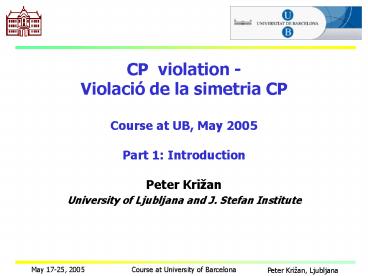Peter Krian PowerPoint PPT Presentation
1 / 21
Title: Peter Krian
1
CP violation - Violació de la simetria CP
Course at UB, May 2005Part 1 Introduction
- Peter Krian
- University of Ljubljana and J. Stefan Institute
2
Introduction to CP
- Initial condition of the universe NB-NB 0
- Today our vicinity (at least up to 10 Mpc)
- is made of matter and not of anti-matter
nb. baryons (matter)
Nb of photons (microvawe backg)
In the early universe B B ? g ? Ng NB NB
How did we get from
(one out of 1010 baryons did not anihillate)
?
to
3
Introduction to CP
- Three conditions (A.Saharov, 1967)
- - baryon number violation
- violation of CP and C symmetries
- - non-equillibrium state
baryon number fb
decay probability
Change in baryon number in the decay of X
4
Introduction to CP
X decays to states with NBa ? NBb -gt baryon
number violation
In the thermal equilibrium reverse processes
would cause DB0 -gt need an out-of-equilibrium
state For example X lives long enough -gt
Universe cools down -gt no X production possible
5
Introduction to CP
C charge conjugation CB0gt B0gt P space
inversion PB0gt -B0gt CP combined operation
CPB0gt -B0gt
6
Introduction to CP
Example t- -gt p- nt
C or P transformed processes forbidden. CP
transformed process allowed
7
CP Violation
- Fundamental quantity distinguishes matter from
anti-matter. - A bit of history
- First seen in K decays in 1964
- Discovery of B anti-B mixing at ARGUS in 1987
indicated that the effect could be large in B
decays - Many experiments were proposed to measure it,
some general purpose experiments tried to do it - Measured in the B system in 2001 by the two
dedicated spectrometers Belle and BaBar at
asymmetric ee- colliders - B factories
8
What happens in the B meson system?
- Why bother? Need at least one more system to
learn more about CP violation. - Kaon system hard to understand what is going on
on the quark level (light quark bound system,
large dimensions), B has a heavy quark. - First B meson studies at ee- colliders with cms
energies - 20GeV, considerably above threshold (2x5.3GeV)
9
B mesons long lifetime
- Isolate samples of high-pT
- leptons (155 muons, 113 electrons) wrt thrust
axis - Measure impact parameter d
- wrt interaction point
- Lifetime implies Vcb small
- MAC (1.80.60.4)ps
- Mark II (1.20.40.3)ps
- Integrated luminosity at
- 29 GeV 109 (92) pb-13,500 bb pairs
10
Systematic studies of B mesons at Y(4s)
11
Mixing in the B0 system
- 1986 Argus discovery of BB mixing B0 turns into
anti-B0 - Reconstructed
- event
Time-integrated mixing rate 25 (270) like
(opposite) sign dilepton events Integrated Y(4S)
luminosity 1983-87 103 pb-1 110,000 B pairs
12
Mixing in the B0 system
- Large mixing rate -gt high top mass (in the
Standard Model) - The top quark has only been discovered several
years later!
13
Expect CP Violation in the B System
- CPV through interference of decay amplitudes
- CPV through interference of mixing diagram
- CPV through interference between mixing and decay
amplitudes
Directly related to CKM parameters in case of a
single amplitude
14
Golden Channel B -gt J/? KS
- Theoretically clean way to one of the parameters
(sin2ß) - Clear experimental signatures (J/? -gtmm-, ee-,
KS-gtpp-) - Relatively large branching fractions for b-gtccs
(10-3)
15
Genesis of Worldwide Effort
16
Contents of this course
CP violation introduction Standard Model a
quick overview CP violation theory CP violation
in the B system CKM quark mixing matrix CP
violation in the K system Experimental
considerations Belle and Babar spectrometers Measu
rements of sin2b
CP violation in b-gts bar s s decays Measurements
of sin2a and g Radiative B decays FCNC decays
b-gts g, b-gts l-l Measuremnets of Vub in
Vcb Mixing measurements Hadron spectroscopy B
physics at hadron machines Next generation of
B-factories
17
Standard Model a quick overview
- Particles
- leptons (e,ne), (m,nm), (t,nt)
- quarks (u,d), (c,s), (t,b)
- Interactions
- electromagnetic
- weak
- strong
18
Standard Model a quick overview 2
- Free fermions satisfy the Dirac equation
- (i gmd/dxm - m) y(x) 0
- Solution y(x) u(p) eipx , px Et -
px - (gm pm m) u(p) 0
19
SM a quick overview 3
- Feynman rules for iM electromagnetic interaction
20
SM a quick overview 4
- Feynman rules for iM for weak interaction via
charged currents similar as for e.m. except - Vertex has an additional (1-g5)/2 factor (weak
interactions only see left handed components - Vertex factor V12 for quarks in charged current
interactions a q12/3 turns into a q2-1/3 quark
(or vice versa), this factor accounts for the
differences in the probability between u-gtd,
u-gts, u-gtb, c-gtd, .... transitions
q2
q1
Vq1q2
W
21
Weak interaction examples
- Muon decay
- Pion decay
- Extraction of Vus/Vud from kaon and muon leptonic
decays - Leptonic B decay

